Cycads: Beware this pretty moth
The Unknown Enemy
For the last three or four years my two cycads (Encephalartos altensteinii), and many others growing in the Bathurst and Port Alfred area, have been attacked by caterpillars. I only really noticed this when the emerging young leaves at the center had vanished beneath a writhing black mass of caterpillars and web-like strands, by which time the damage was beyond repair.
The Culprit
This time around I was fortunate to be working around the area of my cycads and was able to observe the culprits at work. A flock of around 10 or 15 very pretty moths (I thought butterflies) flitted around daintily then descended by ones and twos onto the soft center leaves of the cycad and egg laying began in earnest.
The moth in question is Zerenopsis leopardina, otherwise known as the Leopard Magpie Moth, Pied Leopard Moth or, in Afrikaans, Luiperdmot. This day-flying moth has bright orange wings decorated with neat black markings. It is indigenous to the coastal fringe of KwaZulu-Natal and Mozambique, and further inland in Zimbabwe. I also found a couple of reports of it being more recently found further inland in Mpumalanga, possibly having spread from infected plants being brought into the region. It also appears to have traveled south of its KwaZulu-Natal habitat, but I was unable to find any further clarification.
Zerenopsis leopardina belongs to a group of moths called Looper moths. The larvae or caterpillar of this group appear twig like, often have hairs and because the first 2 or 3 pairs of front 'legs' are missing, they have a rather comical way of moving. The front of the body is extended forward and the rear of the body loops up to meet it.
Because of their diet of cycad, these larvae absorb a certain amount of poison and are distasteful to birds. The colouring also warns off predators.
When the larva reaches its fifth and final skin change, it drops to the ground and pupates in the leaf litter or soil.
The following plant species are known to be hosts of Zerenopsis leopardina:
Maesa alnifolia, Apodytes dimidiata, Carissa grandiflora, Carissa macrocarpa, Encephalartos altensteinii, Encephalartos gilfillani, Encephalartos lebomboensis, Encephalartos princeps, Encephalartos villosus, Strangeria eriopus
Further study has shown that the eggs are invariably laid on plants of the cycad family. Those found on Maesa alnifolia, Apodytes dimidiata, Carissa grandiflora, Carissa macrocarpa and Diospyros lycoides have moved off the cycad only after they have shed a few times.
Leopard moth or Tiger moth?
On the odd occasion comments have referred to the Tiger moth, and I have edited these where possible.Please take note that:
- The specific moth referred to in this article is the Leopard moth, Zerenopsis leopardina, a bright orange coloured moth with very clear black dots, hence the common name Leopard moth.
- The name 'Tiger moth' is used to describe a large group of moths, many, but not all, of which have stripes. These moths belong to a completely different family of moths. There are some amazing moths in this group. For images of Tiger moths, go to: https://www.google.co.za/search?q=tiger+moth+insect&es_sm=93&biw=1237&bi...


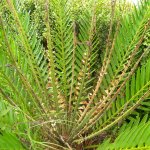

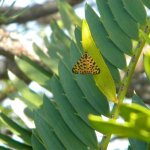
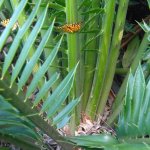
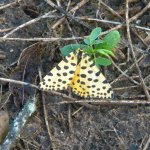
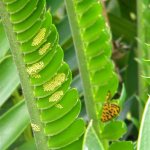



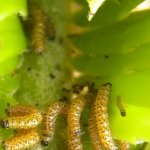
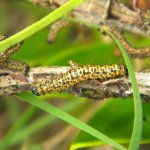
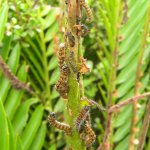


Comments
Leopard moth
They also knock the hell out of my Cycas thouarsi and C. revoluta!
Leopard moth awareness
Hi Robin
Thanks for the warning. I suspect they would probably attack any cycad they come across. The fact that their range seems to be broadening is really worrying.
Leopard moth
Hi Robin
I stay in Montana, Northern Pretoria and in the past two summers I had to spray all my cycads to prevent damage to my plants.
Leopard moth in Pretoria
Hi Leonard
Thanks for your comment and warning. I suspect these moths have infiltrated far and wide. I wonder if it has anything to do with the warmer winters we have been experiencing, in that the weather does not get icy enough to kill off the pupas in winter? All cycad owners will need to keep a careful lookout during spring and early summer.
Kind regards
Lorraine
Moth that damage cycads
Hallo. I saw your comment and would like to know what product did you use to kill the leopard moths. I also live in Montana area.
Leopard Magpie Moth
I'm also staying in Montana Pretoria. This is the first time in 14 years we experience this pest. Not only the cycads, but several other shrubs and trees. My "yesterday, today and tomorrow" was the most beautiful over all the years. It's totally a mess. Leopard tree attacked, seems to me all soft leave plants. These moths are all over my garden.
Leopard moth
Thanks Leonard and Lorraine,
I notice from http://www.africanmoths.com/pages/GEOMETRIDAE/STERRHINAE/zerenopsis%20le... that the distribution of this @#$%^&* moth is given as Mozambique, South Africa, Zimbabwe, so it has a wide distribution.
Hope I'm not talking too soon but neither of my Cycas (thouarsii and revoluta), nor my Encephalartos altensteinii, have been chomped this year but I keep a wary eye on new growth!
Regards,
Robin
Leopard moth distribution
Hi Robin
Thanks for clearing that up. My sources only indicated its distribution in South Africa in KwaZulu-Natal but it is obviously far more widely spread than that.
I had not come across the above website before and I am sure it will come in handy.
Kind regards
Lorraine
Leopard moth distribution
Only this morning I saw the devastation these caterpillars can cause. Two days ago, they weren't there. Today the poor baby cycad, was covered with them and didn't have a single leaf left.
I am on the South Coast of Kenya.
Leopard moth in Kenya?
Hi Pauline
Wow, that is way out of its distribution range. Have you perhaps seen the moth as well? This would make your observation more 'scientific', which would make it possible for me to make a note of this on a research site. Also, do you know which Cycad you have?
I have also had a couple of very small cycads, with only one or two leaves, get eaten to the ground and I thought I had lost them for sure. I was delighted to find them coming up again the next season!
Thanks for your comment and let me know if you have any more information.
Kind regards
Lorraine
Distribution - again
I checked the above site and found only South Africa and Mozambique listed.
Leopard Magpie Moth
There are some people in our near aria moved from Kwazulu here, is it possible that they brought plants carrying these pest here?
Leopard Moth
Hi
May I state that this little pest is driving me mad, I can confirm that ANY Cycad/Cycas is the target!
When not spotted in time it will destroy any new groth in a matter of days. I have seen mature Thoursii plant being stripped in 3 days!
What I need to know is what can be done about these pests? I realy dont care for them at all, the poisons I have been trying on my plants seem to effect the groth of the new leaves (misformed). I have been experimenting with various sprays even lower dosages than prescribed but still the new leavelets are affected and will result in spiraling.
It seems that the Moth is attracted to the cent(?) released released fronm the plant when leaving starts, I have even observed these moths laying eggs on a Cycad groth crown effen before the new leaves have sprouted.
Any help for a desprate Cycad Lover?!
Controlling Leopard moth
Hi Franscois
I sympathise with your plight. I have also noticed that some of my cycad's leaves are deformed, but these were only the ones that were damaged by the larva. I didn't connect the deformity with the poison I had used, but I'll keep a better lookout in future to see if this is the case.
Margarate Roberts has developed a natural product called Dipel, a Biological Caterpillar Insecticide, that is reported to be most effective and may also work for these caterpillars.
For more information about this product, go to: http://www.ballstraathof.co.za/index.php/Insecticides/Margaret-Roberts-D...
If you do try this remedy, please let me know if it is effective or not. There are a lot of people out there who would be interested to know if the product works. (I have not yet tried it as it has not been available in the tiny outpost where I live.)
Whatever you use, the most important thing is to keep a very close eye on the plants during the season - I check mine twice a day. These caterpillars hatch and grow alarmingly quickly as you have seen.
I hope this information is of some help.
Kind regards
Lorraine
leopard moth
Hi.
I use blue death powder by doom. not organic but i am happy with the results.
Yellow moth pests
I propagated cycads since 1965 in Johannesburg, and since 1969 in East London. The large, striped, yellow moth larva lay a few eggs on the underside of old leaves of random plants. Use a 5ml to 1 litre spray when these are seen flying around. The small yellow black spotted moth lays clusters of eggs on the underside of new leaves younger than 3 weeks.
Spray a 1ml to 1 Litre of Ripcord on the eggs. This penetrates the egg case and kills the worms as they chew their way out. About 15 years ago, the TV series 50/50 asked readers to be on the look out for the Tiger moth which appears the be extinct. Many readers sent in pictures of the larger striped yellow moth. But these were not the true Tiger moth which is almost identical, except that alternate black stripes only go down three quarter of the way from top to bottom, whereas all the Tiger moth's stripes go all the way down.
Leopard moth control
Hi Brendan
I agree. I have used it previously for this purpose and it gave instant and effective results.
I changed to one of the liquid insecticides for use on looper worms. My two E. altensteinii have grown to such proportions that it is impossible to reach the crowns through the very spiky foliage. I use a long-handled spray which allows close access to the crowns and under young leaves.
There are just those times when I can't stand back and watch the demise of a valued species. Next season I'll try the organic insecticide.
Regards
Lorraine
Leopard Magpie Moth
Please may you help me distinguish between the Polka Dot butterfly and the Leopard Magpie Moth, I have just taken a photo thinking it was a polka dot butterfly-but now am worried I could be wrong.
Leopard moth versus Polka dot butterfly
Hi Derek
Apologies for making you wait so long for a reply. I had to dive into some rather time consuming research for this, during which time I became ever more confused, but eventually I found the following:
The only visible difference I can see is that the wings of the Polka Dot Butterfly have an edge of black, whereas the Leopard Magpie Moth does not. The plants on which they lay eggs (larval food plants) are also different but this does not help us 'non-experts' much.
For visuals of the Polka Dot Butterfly go to:
http://www.sanbi.org/sites/default/files/documents/documents/bioseries16... (This takes ages to load but is worth a look. The picture is on page 50))
AND
http://en.wikipedia.org/wiki/Pardopsis_punctatissima
For a picture of the Leopard Magpie Moth go to:
http://www.africanmoths.com/pages/GEOMETRIDAE/STERRHINAE/zerenopsis%20le...
How moths are differentiated from butterflies is still a mystery to me because these two critters appear very similar, but for now I've had enough of Lepidoptera. Maybe another reader can explain this?
Kind regards
Lorraine
Leopard magpie moth
Is this an "indigenous" moth? It's very seldom that any indigenous specie is so harmful that it damages it's host plant(s) beyond repair. I've experienced the devastation these moths can cause but, if they are indigenous, shouldn't we be tolerating them? They must have some particular role in the greater scheme of things which we may be missing in our desire for a perfect garden. Oh!! The dilemma of the 'gardener-with-a-conscience', I confess that mea culpa as regards spraying to kill them in the past but if they're indigenous, I shall in the future (reluctantly!!) live and let live!
Leopard Moths
Googled Leopard Moths and Garden Ripcord and came across this wonderful site. Also got massive problems here in East London. Glad to read that Garden Ripcord will kill the eggs but does it damage the leaves? I have also found Blue Death very effective, but would prefer not to use it. I have found the eggs on mature leaves as well and not only in spring or early summer but now in January/February too.
Leopard Moths - East London
Hi Shan
Thanks for your comment.
I seriously doubt that Garden Ripcord will damage the leaves, but if you are concerned, experiment on a small area to ensure that it will not have a negative effect. I am not sure if the poison actually kills the eggs, but I think it coats the egg and when the tiny caterpillars come into contact with the poison, they are killed.
The eggs may be laid on mature leaves, but the emerging caterpillars will quickly move to more tender leaves, as they would be unable to eat the tough mature plant matter. I once came across eggs laid on mature leaves where there are no new leaves on the plant. I think it may be that the female was unable to find a suitable host but had to lay her eggs somewhere.
Your observation of eggs being laid in the later part of summer is quite correct and I should have included it in the blog. They start in spring, which is when one should start looking for them, but seem to keep going until the weather begins to cool in autumn.
Kind regards
Lorraine
Thank you for your prompt
Thank you for your prompt answer Lorraine and complements on such a beautiful website.
Kind regards
Shan
Great photo
Hi Shan
I just had a really good look at this photo. It is stunning!
Kind regards
Lorraine
Leopard Magpie Moth
Oh my goodness, these little bastards totally ruin my beautiful cycad within 2 days and that in late June. Is it because I'm staying in a sub-tropical area and the winter wasn't that cold? or cold enough?
Cycad moths
Hi, I too had the experience of waking up one morning to a thoroughly devastated Cycad Villosus. While picking off inch long worms I noticed tiny beads/barrels (about 5mm long) suspended from many of the leaves. Thinking these were other creatures waiting to hatch and gormandise my cycad I gathered them all into the palm of my hand and stored them in a bottle (with closed lid) until I found out more about them. They were in fact the pupae of ichneumon or Braconid parasitic wasps which are natural predators of these worms. Realising that here, at last, was evidence of a working eco-system in my garden, I hurriedly tossed them back into the cycad to continue their good work. I'm pleased I held off with the spray!
BCA for Leopard moth
I would like to have some picture (or even live ones) of theBraconid parasitic wasps that Gail found on her Cycads. With experience of rearing biological control agents, the most important fact is that pest reproduce in larger quantities than the 'good bugs' The secret is to take the good ones out of nature, reproduce it in an insectary and release large quantities in problem areas to get control. I would love to have some of these parasites together with the Leopard moth eggs in effort to be able to supply these parasites instead of chemicals to restore nature's way. This will be an exiting challenge!
ottoh@mweb.co.za
Braconids
I reckon that the cycad worms would have destroyed all the leaves by the time the Braconid eggs hatch and grow.
I seen very many gardens with permanently neglected cycads, where the Braconids could continue. Moreover, these wasp larvae eat nearly every other known caterpillar - I've seen them on active on many trees.
I would have rather sprayed the cycad larva and eggs.
But, seeing you are trying to do good, carry on as it pleases you.
BCA's for Leopard moth
Good morning
The biggest problem with chemicals it that the resistance when using for a long time. If anyone notice any eggs of the moth colouring, it might be the parasite to control these mothsthe (Braconid parasitic be one ofthem) . I have experience in the rearing of biological control agents for 15 years. Because the population of pests increase much faster than the enemy, it needs to be reared in an insectary-setup to have enough for augmenting the natural enemy. If anyone notice some parasite moth eggs, I would like to try and start a culture for controlling the pest naturally. You can contact me at 0828860751 if you notice parasitized eggs on leaves.
Kind regards
Hannah
Braconid eggs
In nature the quantity of eggs laid by the pests (Leopard moth) is far more than the good ones and therefor when you take the good ones out of nature and increase the population in an insectary, you get control by augmenting the good bugs to decrease the pest population in a short period of time and therefor you will get control before your plants get damaged. One of the negatives of using some chemicals is the fact that you can kill all natural enemies so you will get more and more other pest problems as time goes on.
tiger moths on new cycad leaves
is there a way of preventing the onslaught of tiger moths without poison.please help
Control of Leopard moths
Hi Ron
You can try Margaret Roberts Biological Caterpillar Insecticide. For more information on this go to: http://www.ballstraathof.co.za/index.php/Insecticides/Margaret-Roberts-D...
Kind regards
Lorraine
Leopard Moth caterpillar
Just seen hundreds of these on two Cycad in the garden. I'm in Ballito and it's spring so perhaps they are not only limited to late summer.
Keep a look-out from late winter to early spring
Hi Steve
Not sure where the information about late summer came from, but you did alert me to the fact that I had not mentioned the time of year when these pests erupt.They are active in early spring but this year we had a warm winter and I saw the first few in August. In my garden the caterpillars have disappeared by the beginning of summer.
Kind regards
Lorraine
Eggs of Zerenopsis Leopardina
Hi Lorraine,
Thanks for a very informative website.
I noticed a few pairs of leopard moths laying their eggs on our Lebomboensis new growth yesterday morning, and was just wondering how long the eggs take to hatch, just so i have an idea on how long i have to find the suitable insecticide?
Kind regards
Neil
Leopard moth eggs
Hi Neil
I actually don't know how long the eggs take to hatch. The eggs change colour from yellow to grey, meaning that the larva are developing and will hatch in a day or two.
An excellent organic product is Margaret Roberts Biological Caterpillar Insecticide. Any product with 'Dipel' as its active ingredient can be used with minimum damage to the environment and other wild life. These products are specifically targeted for caterpillars and will not affect other creatures.
If you can't get hold of organic preparations you can use poisons such as Chlorpyrifos, Blue death, Ripcord or others, bearing in mind that these poisons will kill all insect life and have a negative impact on other wildlife forms.
You could also put on a pair of gloves (I find this an icky business) and simply wipe off the eggs wherever you see them.
Kind regards
Lorraine
Leopard moth
Hi Neil, eggs hatch quicker when wet (Rain/hose) average 18 days. 5ml Ripcord to a litre of water penetrates the shell and the worms die as they eat their way out. However, most insecticides are dangerous even if inhaled.
I preferred to inspect all new growth twice a week and use soap on a damp dish cloth to wipe off any eggs. They come off easier when newly laid.
This method will not work for the larger striped cycad moth which prefers to lay its eggs on the under side of matured leaflets.
Soon after seeing these yellow moths with vertical black stripes flying around, spray all cycads with a stronger mixture. These moths are almost identical to the endangered Tiger moth which has slightly longer vertical stripes.
Leopard Moth duration
Here in East London we had a problem throughout spring and summer so I suggest people be vigilant then too.
Leopard moth and caterpillar control
I use blue death. They vigorously attack my cycads on the KZN south coast, to the extent of destroying all new growth and even male/female flowers, which were plentiful a couple of years back with many naturally propagated seedlings. I find they are no longer seasonal bound but year round after rain. I douse all new growth with blue death powder before and even after eggs are spotted as it seems to work. My question, as I am not there year round is: Are the generations genetically linked to a plant or area as since I started with this the return of moths has reduced. I will continue with this as much as I dislike using pesticides harmful to environment and other creatures in order to eradicate them as it seems they are void of any natural predators.
Blue Death
Hi Neil. I hate to admit I also use Blue Death in desperation on my cycasses but especially for the amaryllis worm that is destroying all my Amaryllis, Clivias and Agapanthus. Agapanthus used to be a Landscapers dream, now a nightmare along with another staple, Impatiens
Cycad Leopard moth
I have picked about 100 worms off my cycads today - unfortunately too late to save many leaves. I couldn't understand why the birds were not eating them, until I read this article. Thanks for an informative article.
Leopard magpie moth
Good day. I live in Tzaneen in the Limpopo province. We have a huge problem with these moths. They eat every little leaf coming out.
Leopard moth in Limpopo
Hi Petrus
You are not alone! I have managed to control the pests on my plants but it takes constant vigilance and immediate action. As winter ends I visit my Cycads daily, sometimes twice a day, until at least the middle of summer.
Kind regards
Lorraine
Leopard Moth on Cycads
I am going through hell with this Leopard Moth laying eggs on the Cycad plant
and after a few days if not checked can completely destroy the whole plant (New Leaves)
I have tried various poisons but to no avail. It is so bad now the new plant
leaves don't even have a chance to come out and the moth starts laying the eggs
already. I was even informed to spray Cockroach Spray on the leaves. This made such a mess of my plant I had to cut all the leaves back and start all over again
What can I buy to rid these pests?
I stay in New Germany, Durban, South Africa . Please Help.
Tony da Canha
Leopard Moth caterpillar
Hi Tony
All your queries have been answered in the above article and comments. If there is anything else you would like to know, that is not already discussed above, please don't hesitate to contact me again.
Kind regards
Lorraine
Leopard Moth
I am please to see that there are some discussions on this issue.
Look, don't misunderstand me, when it comes to nature and her inhabitants I am all for save and let live, but when it comes to my Cycads I am very one side in this battle, my plants comes first!
I don't know how many are privileged to poses either a Relictus or a hirsitus, and to see a WORM (aka caterpillar) devour new growth on those plants that we have been awaiting in great anticipation for almost 3years is not fun or funny.
In my garden (300 + Cycads)we on a daily basis need to inspect all new growth for these eggs, to remove these eggs before they hatch I found to be worth the effort as when these small WORMS creep out of there eggs they are munching machines!
Now my reason for actually posting this communication, how do these insects find their respective hosts, there are some species that attract these moths more than others. could it be that some hormone of sorts are produced during leaving? If this be the case, then surely we could design traps that will attract these insects!
If you have an opportunity, please sit and note how these insects find your plant, it is like a shark zooming in on a bleeding prey!
ps: Don't use aerosol sprays on the new leaves (DOOM, TARGET, etc) as these will result in miss-formed leaves as mentioned by TONY!
Please comment.
Thanks
What is this on my Cycass?
I have managed to get the leopard moths under control but noticed these today on one of my cycasses. Is it white fly or something else i.e. mould?
Cycad scale
Hi Shan
Oh dear. You just get rid of one pest and another raises it's head.
I’m pretty sure this is a a kind of scale insect.
Here are three sites with pictures of Cycads that look very similar to your Cycass:
http://cycadjungle.8m.com/cycadjungle/The%20Asian%20Cycad%20Scale.html
http://www.plantapalm.com/vce/horticulture/asiancycadscale.htm
http://www.freshfromflorida.com/pi/pest-alerts/aulacaspis-yasumatsui.html
Perhaps these sites will give you some ideas of what to do for your plants.
They look as if they need urgent attention and you may want to apply a scale insecticide as soon as possible anyway.
Google 'Margaret Roberts organic scale insecticide' for a possible solution, or ask at your nursery for advice.
Kind regards
Lorraine
Asian Scale on Cycasses
Thank you so much, Lorraine. It definitely looks like Asian scale. Will try to eradicate them and let you know. Looks like it's not going to easy.
Kind regards
Shan
Leapard moth
I stay in Tzaneen. Leopard moths were observed in town 11 years ago. They moved east 4 years later +-12 km. I know they are in Letsitele 11 years later, and also further east. They sleep in big trees in the tops (look in the late afternoon). In time they will destroy the Modjadi forest, if they have not already started. I use Cypermetrine at 1% on all the soft leaves every weak. Blue death can burn soft leaves.
Leopard moth in Mpumalanga
Hi Kobus
Thanks for the useful observation and tips.
Kind regards
Lorraine
Leopard moth Magoebaskloof
Hi Kobus,
We have been battling with the Leopard moth for the past 2 years.
We have been spraying them in all stages, killing the moth, and the larvae. But it has been an endless battle.
Even now in late April the larvae is in full action. They are not only attaching the cycads, the larvae eggs have been hatching on numerous trees and even bromeliads. So the matter is getting worse.
Best Regards,
Etienne Bosman
Magoebaskloof
Leopard moth invasion
Hi Etienne
Thanks for your input and warnings. Would love to have some photos of the larva on the other plants and the names of the trees being targeted.
Kind regards
Lorraine
Leopard moth control
I have many cycads of various species. As new growth appears I spray the new leaves with a solution of Kemprin (10ml : 5L) I add a few drops of dish washing liquid as a wetting agent. I've been doing this for many years and no longer have any problems. The month's seem to detect that the leaves aren't suitable and go elsewhere.
Leopard moth control
I have many cycads of various species. As new growth appears I spray the new leaves with a solution of Kemprin (10ml : 5L) I add a few drops of dish washing liquid as a wetting agent. I've been doing this for many years and no longer have any problems. The month's seem to detect that the leaves aren't suitable and go elsewhere.
leopard moth
I use the insecticide Knox Worm
Leopard Magpie Moth damage
Hi Lorraine
Thanks for all your advise above. I have simular problems and are wondering if there is something systematic on the market, so as the baby worm starts eating, he dies off at an early stage before causing too much damage
Thanks
Inus - Pinetown
Killing the culprit
Hi Inus
My apologies for taking so long to reply to your query.
An excellent organic product is Margaret Roberts Biological Caterpillar Insecticide. Any product with 'Dipel' as its active ingredient can be used with minimum damage to the environment and other wild life. These products are specifically targeted for caterpillars and will not affect other creatures.
Kind regards
Lorraine
Found in Pmb garden
Thank you for this very useful and informative website! As you are recording sitings of this moth, I would like to report that I found the caterpillars devouring my cycad in Pietermaritzburg. I've had them for some years now.
Invested
We had an infestation not long ago with so many worms on our cycad leaves we killed them off (see pic 1), but now we sit with an infestation of moths. Does anyone know what moth this is and what must we do? There are hundreds. Worst if the powder from the wings get on you it itches like crazy.
black spots on cycad leaves.
I discovered some of my cycad leaves have black spots in the leaves. at the tip of the leaves is a jelly like thing and some of the new leaves are deformed.
any idea what I can spray/
mostly on Natalensis and ferox
thanks
Ways to prevent and control Leopard Moth
Hi, I am looking for some natural enemy. Life cycle: Moth, Egg, Larvae pupae. Pupae fall down into the soil - remove the soil and destroy them will boiling water or make a fire to burn over it. There might be some survival (pupae on plant where not visible). A yellow sticky trap near the plant might attract and catch moths that did survived.
Hannah Otto
New ideas
Hi Hannah
Love your ideas - that's thinking out of the box.
I wonder if/how one could use the sticky trap idea to catch the moths before the eggs are even laid?
Warm regards
Lorraine
Add new comment